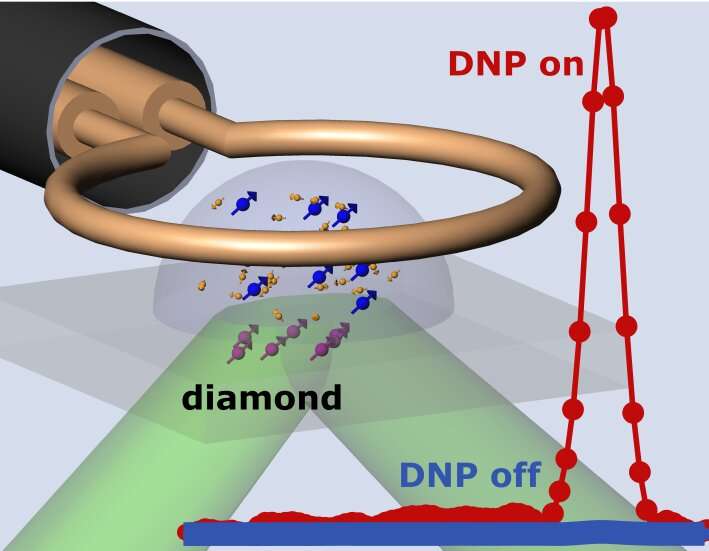New quantum sensing technique allows high-resolution nuclear magnetic resonance spectroscopy

Nuclear magnetic resonance (NMR) spectroscopy is a widely used tool for chemical analysis and molecular structure recognition. Because it typically relies on the weak magnetic fields produced by a small thermal nuclear spin polarization, NMR suffers from poor sensitivity compared to other analytical techniques. A conventional NMR apparatus typically uses large sample volumes of about a milliliter—large enough to contain around a million biological cells.
In a study published in Physical Review X (PRX), researchers from the University of Maryland's Quantum Technology Center (QTC) and colleagues report a new quantum sensing technique that allows high-resolution NMR spectroscopy on small molecules in dilute solution in a 10 picoliter sample volume—roughly equivalent to a single cell.
The experiments reported in the paper, entitled "Hyperpolarization-Enhanced NMR Spectroscopy with Femtomole Sensitivity Using Quantum Defects in Diamond," were performed by the research group of Prof. Ronald Walsworth, QTC Founding Director. Their finding is the next step in previous results, in which Walsworth and collaborators developed a system that utilizes nitrogen-vacancy quantum defects in diamonds to detect the NMR signals produced by picoliter-scale samples. In this past work, the researchers could only observe signals from pure, highly concentrated samples.
To overcome this limitation, Walsworth and colleagues combined quantum diamond NMR with a "hyperpolarization" method that boosts the sample's nuclear spin polarization—and hence NMR signal strength—by more than a hundred-fold. The results reported in PRX realize, for the first time, NMR with femtomole molecular sensitivity.
On the impact of the research, Walsworth says, "The real-world goal is to enable chemical analysis and magnetic resonance imaging (MRI) at the level of individual biological cells." MRI is a type of scan that can process detailed pictures of parts of the body, including the brain. "Right now, MRI is limited in its resolution, and it can only image volumes containing about a million cells. Seeing individual cells noninvasively with MRI (to help diagnose illness and answer basic questions in biology) is one of the long-term goals of quantum sensing research," says Walsworth.
The research paper, "Hyperpolarization-enhanced NMR spectroscopy with femtomole sensitivity using quantum defects in diamond," Dominik B. Bucher, David R. Glenn, Hongkun Park, Mikhail D. Lukin, and Ronald L. Walsworth, appears in the June 2020 issue of the journal Physical Review X.
More information: Dominik B. Bucher et al, Hyperpolarization-Enhanced NMR Spectroscopy with Femtomole Sensitivity Using Quantum Defects in Diamond, Physical Review X (2020). DOI: 10.1103/PhysRevX.10.021053
Journal information: Physical Review X
Provided by University of Maryland




















